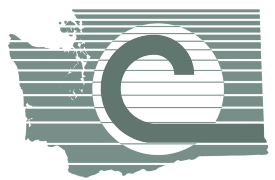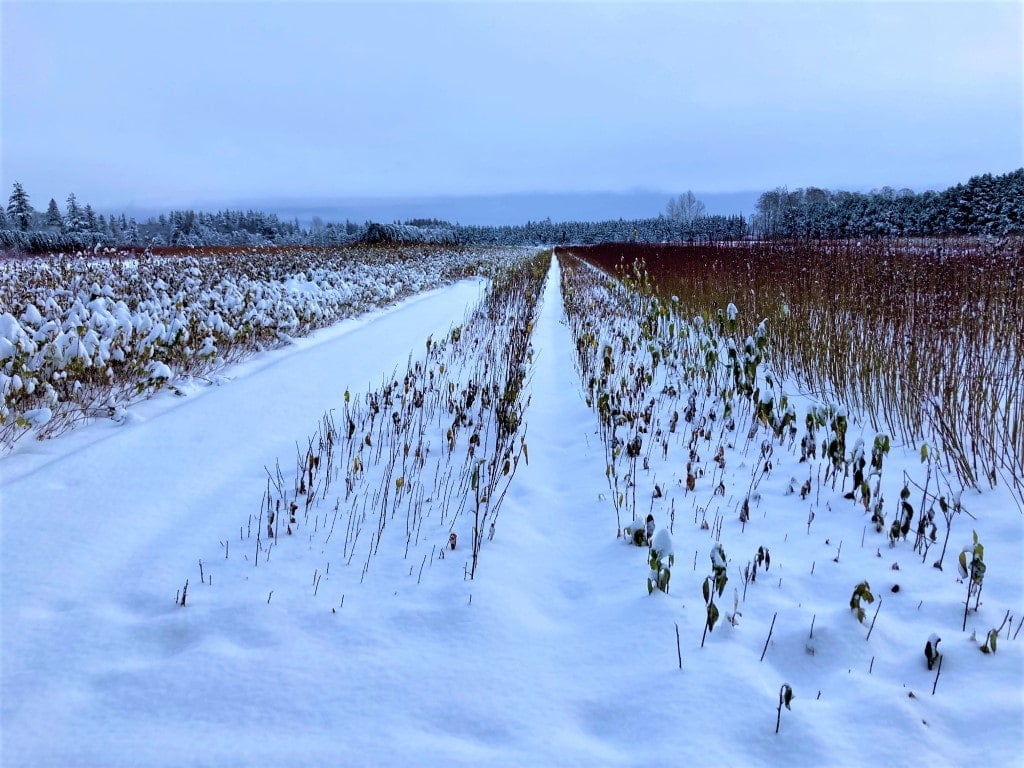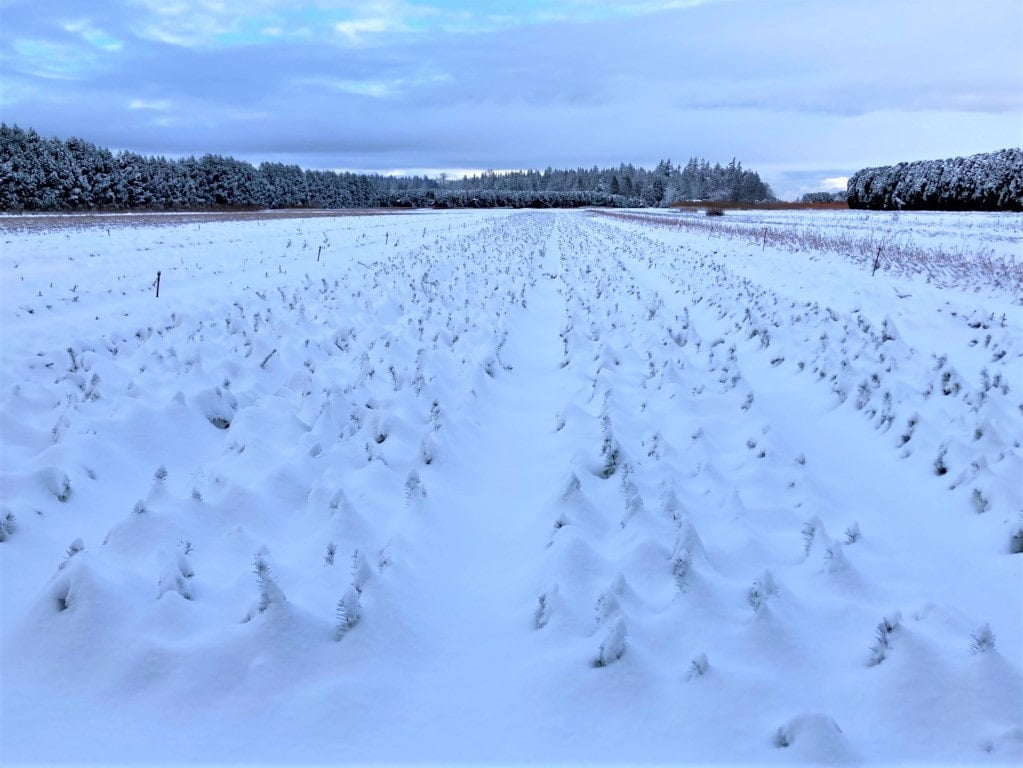Plant Materials Center Update: December 20, 2022

The past week has been slow with the weather-related slowdown in harvest and shipping. Instead of the usual 5 Things update, here is an A-to-Z update of 2022 at the PMC.
A – We are Appreciative that we had one very qualified Applicant to fill the Farm Operations Supervisor position when Bill Mulder retires. His name is Oscar Arias and thankfully he is a good-natured, hardworking, quick study.
B – Once again, a cover crop of Barley was planted on the fallow ground to build up the soil before being planted into seedbeds and transplant beds.
C – It looks like most of the Conifers that the PMC has grown for this year have been sold. Between wildfires, reforestation and restoration, demand has continued to exceed production.
D – The PMC has had the good fortune to have Skagit Conservation District Forester Nick Kunz and Drone pilot extraordinaire help the PMC look into potential applications of Drone generated imagery. The suite of analytical software is increasing the uses of Drone imagery to include plant stress detection and even possibly field inventories.
E – Without dedicated Employees, the PMC would not have the capacity it does. The PMC is more than a sum of its parts thanks to its Employees.
F – Between last year’s harvest and this year’s so far, 2022 has seen more days of Frozen ground than ever before. The Freezes this year have come unusually early and Frequently. Hopefully, that does not carry into 2023 too much or it will become difficult to keep up with harvest.
G – Assistant Manager John Knox has researched and worked on the Missouri Gravel Beds for a few years now. It has gone from proof of concept to operational with the first surplus plants from last year’s harvest plants being sold for fall planting this year with plants that were carried over in the Gravel Beds.
H – The PMC would not be able to operate at its current capacity without a lot of Help from so many. From WACD Officers, Directors, Committees, Members from across the state, customers and interested parties the PMC has been able to see production levels never dreamed of not that long ago.
I – The PMC is so happy to have found a high-speed Internet provider. In recent years the only Internet Service Providers were cell phone companies that did not provide the speed, capacity, and reliability needed to run a business. A company called Pogozone provides local wireless connectivity with more than sufficient speed, capacity, and reliability.
J – Sales Manager Jacquie has done an amazing job helping customers with a wide range of needs and expertise, maintaining inventory, entering and managing orders, and arranging shipping and pickups.
K – Administrative Assistant Lori is a Keyboard sensation. Her Keyboard must get smoking hot with all of the invoicing, human resource work, generating financial reports, and keeping up with withholding and taxes that she does.
L – One of the hardest working and least appreciated implements at the PMC is the Lifter. It is attached to the heaviest tractor at the PMC and is pulled through the ground while it Lifts bare root seedlings onto the surface of the ground. Without that the PMC would be unable to provide plants.
M – An unseen super-hero at the PMC is the Mycorrhizal fungi the PMC inoculates its plants with. They form a symbiotic relationship with plants. They enable the plants to access more nutrients and moisture and the fungi get some sugars from their host in return.
N – Another unseen important activity that occurs at the PMC is Nighttime frost protection. That is the practice of using latent heat in irrigation water to provide a few degrees of protection from freezing when the plants are not yet fully dormant. It involves coming in at Night when the temperature drops below freezing and turning on the irrigation which runs until the temperature rises above freezing. Once the plants achieve full dormancy as determined by meeting a chill requirement the practice is discontinued.
O – The number of Orders the PMC received and processed during the 2021-22 season was record-setting with 557 separate Orders. So far, the 2022-23 harvest season is on pace to rival that with over 250 Orders received.
P – The Processes of Producing Conservation Plants can be sufficiently onerous to obscure what is truly important and that is the Plants themselves. Once in a while, one should step back and look at the marvel of what is being Produced. They are self-sufficient organisms that generate energy from the sun to locally source nutrients and water to enable them to grow and reproduce while providing wildlife habitat, cooling shade, soil building and stabilization, and water filtration while providing oxygen and sequestering atmospheric carbon.
Q – The 2021-22 harvest season saw increases in the Quantity and Quality of plants produced at the PMC. Over 2 million plants were shipped out to their forever home. This year’s harvest is on track to surpass that!
R – One of the important Resources that help make the PMC work is the Relationships it has developed. That includes a wide variety of customers, vendors, and supporters. In developing these Relationships, the PMC understands the needs and capacities of others while they learn what the PMC is, how it operates and what it can and cannot offer.
S – It Seems that the importance of Seeds from native plants are Starting to become recognized. They are as diverse as the flora of the region which would not exist without them. They range in size from 80 per pound to millions per pound with equally diverse requirements for germination and growth. As demand for native restoration plants grows more and more Seeds are needed, obtaining the right Seeds is becoming a problem, especially when Seed production varies from year to year from record yields to none.
T – The PMC produces a lot of plug-1 conifers from small Transplant plugs. The number of which increases year to year which unfortunately does not keep up with rising demand. The PMC will continue to grow more and more Transplants but anyone who knows they need them in the coming years should consider contracting to better ensure they have what they want when they need them. Increasing costs of Transplants make speculating on future demand even riskier which play an important factor in increasing production.
U – Another Underappreciated implement used at the PMC is its Undercutter, or root-pruner. It has a sharp reciprocating blade that is pulled through the ground during the growing season. If done properly it cuts off the plants root tips which causes the root system to branch out more, resulting in a more fibrous root system that produces a plant better able to survive and thrive after out-planting.
V – It can be said that a business is no better than its Vendors and that is well understood at the PMC. We rely upon them for seeds, transplants, ag chemicals, packaging, shipping, equipment, and parts to name a few. If it is not adequately supplied in a timely and cost-effective manner many aspects of the operation may cease. Knowing how one’s Vendors operate, what they can provide and when they can provide it, and what they are unable to do is Vital to keeping things moving along.
W – If one had to identify one reliable constant in this operation, that would be the understanding that the Weeds need managing every year forever and ever. Learning how to live with this reality has come from years of hard-fought lessons.
X – An important part of learning to grow quality conservation plant materials is learning how the Xylem cells in a plant work and affect the plant-water relationship. The Xylem cells in a plant are tasked with moving water up and down in a plant via evapo-transpiration and capillary adhesion and cohesion. Too little water in the system and the water column moving through these cells can cavitate interrupting flow. Too much water may result in edema that ruptures the cells. Xylem cells do a lot for being physiologically dead.
Y – The PMC is finishing its 30th Year in operation. It has learned and developed a lot over that time as well as produced millions of plants.
Z – Zero is the number of plants that the PMC would like to be left over at the end of a sales and shipping season. Of course, given the speculative nature of the market combined with the lead time needed to plan and grow a crop, that will remain an unattainable goal. Being too cautious can lead to underproducing stock. One cannot sell what one does not have. The number of unsold plants last year was relatively low and hopefully, that trend continues with this year’s crops.
I hope this helps. Please let me know if you have any questions. You can find older posts about the Plant Materials Center at https://wadistricts.us/topics/wacd/pmc/
Jim Brown
Director of Nursery Operations



